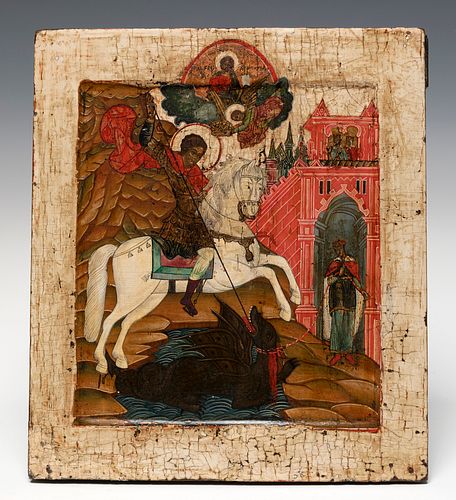Russian school, first half of the XVI century. "St. George slaying the dragon". Tempera on panel.
Lot 105
About Seller
Setdart Auction House
Carrer Aragó 346
Barcelona
Spain
Setdart Subastas was born in 2004 and is currently the first online art auction in Spain with solidity, prestige and reliability guaranteed by our more than 60,000 users. Setdart has a young, dynamic and enterprising team ready to successfully manage the purchase and sale of art works through custom...Read more
Estimate:
EUR€8,000 - EUR€10,000
$8,333.33 - $10,416.67
Absentee vs Live bid
Two ways to bid:
- Leave a max absentee bid and the platform will bid on your behalf up to your maximum bid during the live auction.
- Bid live during the auction and your bids will be submitted real-time to the auctioneer.
Bid Increments
| Price | Bid Increment |
|---|---|
| EUR€0 | EUR€10 |
| EUR€200 | EUR€25 |
| EUR€500 | EUR€50 |
| EUR€1,000 | EUR€100 |
| EUR€3,000 | EUR€200 |
| EUR€5,000 | EUR€500 |
| EUR€10,000 | EUR€1,000 |
| EUR€20,000 | EUR€2,000 |
| EUR€50,000 | EUR€5,000 |
About Auction
By Setdart Auction House
Nov 3, 2021
Set Reminder
2021-11-03 08:00:00
2021-11-03 08:00:00
America/New_York
Bidsquare
Bidsquare : OLD MASTERS
https://www.bidsquare.com/auctions/setdart-auction-house/old-masters-7786
Setdart Auction House sofia@setdart.com
Setdart Auction House sofia@setdart.com
- Lot Description
Russian school, first half of the XVI century. "St. George slaying the dragon". Tempera on panel. Measurements: 35,5 x 31 cm. The legend of St. George is one of the most recurrent passages in Christian literature and iconography. The first mentions of St. George as a martyr appear already in the V century, and are initially limited to a specific territory: Cappadocia (the legend says it was his birthplace), Nicomedia and Diospolis (Lydia). According to the first versions of hagiography, George suffered torture at the hands of the Persian king Dadian; this character was later replaced by the historical figure of Emperor Diocletian. In the period after the iconoclastic period, around the 11th century, to the account of George's numerous tortures is added the developed cycle of miracles. It is believed to have been created mainly among Eastern monastic circles. The most popular of the miracles, "The miracle with the dragon", the one depicted on our icon, in the central square. This legend dates back to the oral tradition of the eighth century; in manuscripts it is not recorded for the first time until the twelfth century. However, these dates may find variations in different historical sources. In Russia, the cult of St. George begins to gain popularity around the 11th century coinciding with the reign of Yaroslav the Wise. The iconography of the icon auctioned, presents St. George with all the attributes of a warrior martyr, including the crown of palms that an angel is bringing down from heaven, an unusual detail, and therefore curious. The symbolism of St. George slaying the dragon goes back to early Christian beliefs, which form, practically, the basis of all Christianity, of the struggle between good and evil. Towards the end of the 15th century, the iconographic prototype began to be enriched with new details, such as the angels, the representation of the Pantocrator, or the architectural motifs and the maiden. The icon of interest tells one of the most legendary passages in the life of St. George. According to Christian tradition in general, this miracle happened after the death of the saint. There are different versions of the miracle, the traditional one relates, that in a lake near a certain city, a dragon settled, and destroyed the city with its poisonous breath. The ruler of this pagan city invoked the gods and they advised him to sacrifice a young man or woman to the beast every day. The ruler promised that if the fate fell on his only daughter, he would share the fate of the other victims. When his turn came, he was led to the shore of the lake, where the monster dwelt. Suddenly a rider on a white horse appeared, and pounced on the snake that had emerged from the lake. He pressed the monster's larynx against the ground with his spear, and the horse began to trample it with its hoofs. Then the warrior ordered the maiden to put a belt on the subdued snake, and take it to the town. The townspeople, seeing the beast led like a docile dog, stood still in amazement. Then St. George explained to them that he had defeated the serpent by the power of Christ. In gratitude for what had happened, the inhabitants were baptized. In compositional terms, the icon presents some characteristics, typical of Orthodox icon painting. In the foreground appears the saint, in a larger size than all the other characters, also marking the hierarchy. The architectural motifs are painted in reverse perspective, showing the viewer the buildings both from above and below, to provide maximum information about the scene. The icon is astonishing for its wide chromatic range and the great detail achieved by this anonymous painter.
- Shipping Info
-
In-house shipping available. Please inquire at admin@setdart.com.
-
- Buyer's Premium



 EUR
EUR CAD
CAD AUD
AUD GBP
GBP MXN
MXN HKD
HKD CNY
CNY MYR
MYR SEK
SEK SGD
SGD CHF
CHF THB
THB

















